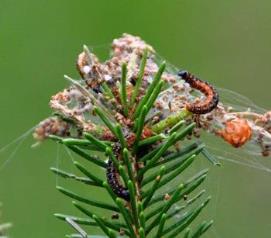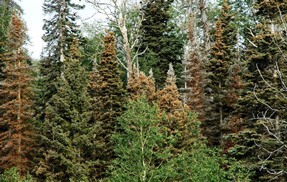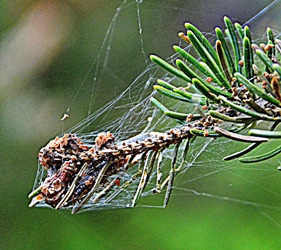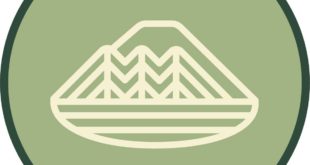Michigan Department of Natural Resources forest health staff is in the process of mapping the extent of this year’s spruce budworm  damage to balsam fir and white spruce in the Upper Peninsula and northern Lower Peninsula.
damage to balsam fir and white spruce in the Upper Peninsula and northern Lower Peninsula.
The last widespread outbreak of the insects in Michigan ended during the 1980s. Experts think we may be seeing the beginning of a new epidemic that will persist over the next several years.
“The spruce budworm has finished feeding for the year in most areas,” said Bob Heyd, a DNR forest health specialist in Marquette. “There are a few larvae still chewing on needles, but most have turned into pupae.”
Over the past few years, countless trees have been damaged by the budworm, which is one of the most destructive native insects in the northern spruce and fir forests of the eastern United States and Canada.
“Many areas in the western U.P. were hit last year for the first time, yet other areas have been hit off and on for several years,” Heyd said. “Spruce budworm is much more widespread this year. The damage varies throughout the area.”
Periodic budworm outbreaks are part of the natural cycle of events associated with the maturing of balsam fir and white spruce. Every 30 to 50 years, large-scale outbreaks cause widespread top kill and tree mortality.
Balsam fir is most severely damaged by the budworms. During Michigan’s last outbreak, 67 percent of the balsam fir and 42 percent of the white spruce were killed. Budworms also feed on black spruce, tamarack, pine and hemlock trees when they are in stands with balsam fir or white spruce, but these species generally suffer less damage.
The DNR has begun mapping flights over this year’s budworm-affected areas.
It initially appears places hardest hit this year are in the western Upper Peninsula, south of an east-west line bounded on the north by the Lake Michigamme area in Marquette and Baraga counties and on the east by U.S. 41 between Marquette and Rapid River in Marquette, Alger and Delta counties.
 “Eastern Mackinac and Chippewa counties, east of the Hiawatha National Forest, also have impacted areas,” Heyd said. “The southeast northern Lower Peninsula has also reported areas of heavy defoliation.”
“Eastern Mackinac and Chippewa counties, east of the Hiawatha National Forest, also have impacted areas,” Heyd said. “The southeast northern Lower Peninsula has also reported areas of heavy defoliation.”
Spruce budworms overwinter as tiny caterpillars that disperse by dropping from treetops on webs. As new tree growth expands in the spring, the caterpillars grow and feed on new shoots. Budworms produce one generation each year.
Repeated budworm defoliation can cause top kill and tree mortality in older and stressed trees. Balsam fir older than 60 and spruce over 70 years old provide prime infestation opportunities.
Younger trees infested with spruce budworms lose much of their new growth, but generally survive.
Heyd recommends that residents with defoliated trees wait until late summer or early fall to assess budworm damage.
“After rains wash the brown needles from the trees, they will look much better,” Heyd said. “You can then see how much foliage remains.”
Stands defoliated for more than one year can have heavy mortality or may have trees with dead tops. Stands with a lot of dead tops often do not recover.
Marquette County resident Thom Skelding is one landowner who experienced spruce budworms infesting his balsam firs. Earlier this month, as trees greened, the brown, dead needles were clearly visible. He worried three giant trees providing cover at his bird feeders might have to be cut down.
“I tried mowing underneath one, but there were dozens of caterpillars dangling on silk lines at face level,” Skelding said.
A week later, Skelding was amazed at the number of caterpillars on his firs.
 “They were literally on the end of every branch with a web,” Skelding said.
“They were literally on the end of every branch with a web,” Skelding said.
Skelding said warblers and sapsuckers were taking advantage of the infestation, with plenty of caterpillars available to feed their young.
He said even the small balsams had budworms and larger trees next to openings or in openings had been hit the hardest. Over the past few days, Skelding said the caterpillars appeared to largely be finished feeding.
Heyd said now that feeding is over, spraying trees this year will not protect them.
In a week or two, small copper-colored budworm moths will emerge and begin laying eggs. In areas that have been heavily hit for two or more years, many of the moths will migrate to new areas where there are more new spruce and fir needles on which to lay eggs.
“These eggs will ‘hatch’ in a week or two depending on the weather,” Heyd said. “These tiny larvae will do no noticeable damage and will overwinter. Next spring when the weather warms, they will become active. They will feed in newly expanding buds. As soon as these buds expand and shed their bud caps, the trees can be sprayed to protect them from being defoliated.”
Heyd said next year tree owners should check trees in late May or early June for small budworm larvae. Only one pesticide application is necessary.
Since 1909, there have been waves of spruce budworm outbreaks throughout the eastern United States and Canada. These outbreaks typically have lasted for 10-15 years and have resulted in the loss of millions of cords of spruce and fir.
The last outbreak in Michigan started in the Upper Peninsula in the late 1960s and ended in the early 1980s. As a result, spruce and fir tree mortality was mapped on 519,000 acres in Michigan.
Heyd said due to the extent and age of the spruce-fir resource, and the fact that it has been about 40 years since the beginning of the last outbreak, another regional spruce budworm epidemic has likely arrived.
For more information on forest health issues, including a Frequently Asked Questions page on the spruce budworm, visit www.michigan.gov/foresthealth.
 Keweenaw Report Your Source for Local News and Sports
Keweenaw Report Your Source for Local News and Sports





